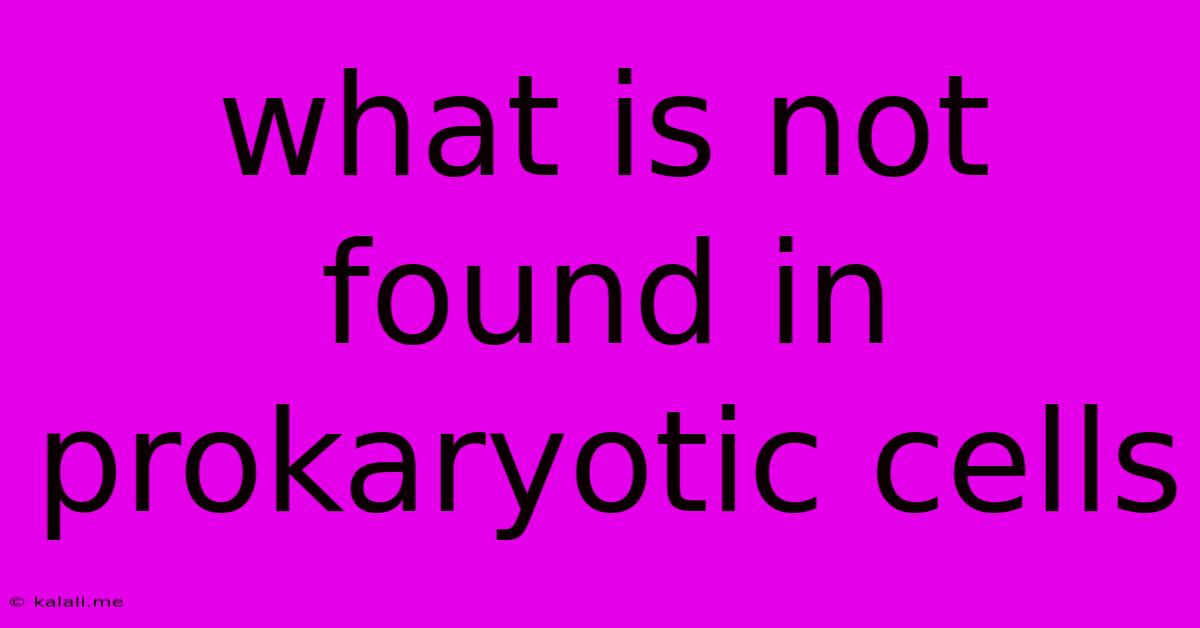What Is Not Found In Prokaryotic Cells
Kalali
Jun 15, 2025 · 3 min read

Table of Contents
What's Missing in Prokaryotic Cells: A Deep Dive into Eukaryotic Distinctions
Prokaryotic cells, the simpler of the two fundamental cell types, are fascinating in their efficiency. But their simplicity means certain structures and processes found in their more complex cousins, eukaryotic cells, are absent. Understanding these absences is key to grasping the fundamental differences between these two cell types. This article explores the key cellular components and processes not found in prokaryotic cells, offering insights into their evolutionary divergence and functional implications.
What are Prokaryotic Cells? Before delving into what's missing, it's crucial to establish a baseline. Prokaryotic cells, the defining characteristic of bacteria and archaea, are generally smaller and less complex than eukaryotic cells. They lack a membrane-bound nucleus and other membrane-bound organelles. This lack of compartmentalization is a significant distinction from eukaryotes.
Key Cellular Structures Absent in Prokaryotic Cells:
Several key structures are absent in prokaryotic cells, fundamentally shaping their structure and function:
-
Membrane-bound Organelles: This is perhaps the most significant difference. Prokaryotes lack the intricate internal membrane systems that define eukaryotic cells. This means they lack organelles such as:
- Mitochondria: Responsible for cellular respiration and ATP production. Prokaryotes generate ATP through processes occurring in the cytoplasm.
- Endoplasmic Reticulum (ER): The ER plays a crucial role in protein synthesis, folding, and modification, and lipid metabolism. Prokaryotes manage these processes differently, lacking the organized structure of the ER.
- Golgi Apparatus (Golgi Body): This organelle processes and packages proteins for secretion. Prokaryotic protein secretion mechanisms are distinct and less complex.
- Lysosomes: These organelles are responsible for waste breakdown and recycling. Prokaryotes handle waste disposal through different mechanisms.
- Chloroplasts: Found in plant cells, chloroplasts are responsible for photosynthesis. Photosynthetic prokaryotes (cyanobacteria) carry out photosynthesis using internal membrane systems, but not in chloroplasts.
- Vacuoles: These membrane-bound sacs store water, nutrients, and waste products. Prokaryotes manage storage differently, often relying on inclusion bodies within the cytoplasm.
-
Nucleus: The defining feature of a eukaryotic cell is its nucleus, a membrane-bound organelle containing the cell's genetic material (DNA). In prokaryotes, the DNA is located in a region called the nucleoid, which is not enclosed by a membrane. This means the DNA is directly exposed to the cytoplasm.
-
Cytoskeleton: The intricate network of protein filaments that provides structural support and facilitates intracellular transport in eukaryotes is largely absent in prokaryotes. While some prokaryotes possess proteins with cytoskeletal-like functions, the complexity and organization are far less developed.
-
Complex Internal Membrane Systems: Beyond the lack of specific organelles, prokaryotes generally lack the extensive network of internal membranes that compartmentalize various cellular processes in eukaryotes.
Cellular Processes Absent or Different in Prokaryotic Cells:
The lack of certain structures directly impacts cellular processes:
- Complex Cellular Signaling: The intricate signaling pathways found in eukaryotic cells, involving various organelles and receptors, are less complex in prokaryotes. Their communication systems are adapted to their simpler cellular organization.
- Endocytosis and Exocytosis: These processes, involved in transporting materials into and out of the cell using vesicles, are fundamentally different in prokaryotes.
Evolutionary Implications:
The absence of these components suggests prokaryotes represent an earlier stage in cellular evolution. The endosymbiotic theory proposes that mitochondria and chloroplasts originated from prokaryotic organisms engulfed by early eukaryotic cells. This theory explains the presence of their own DNA within these organelles, a remnant of their independent existence.
Understanding what isn't present in prokaryotic cells provides crucial insights into the evolutionary journey of life on Earth and highlights the remarkable complexity of eukaryotic cells. The differences between prokaryotic and eukaryotic cells are fundamental, showcasing the diverse strategies organisms have developed to survive and thrive.
Latest Posts
Latest Posts
-
What Are All The Factors For 75
Jun 15, 2025
-
The Main Nitrogenous Waste In Urine Is
Jun 15, 2025
-
What Is The Second Most Abundant Gas In The Atmosphere
Jun 15, 2025
-
The Most Abundant Molecule In The Cell Is
Jun 15, 2025
-
What Is The Multiples Of 50
Jun 15, 2025
Related Post
Thank you for visiting our website which covers about What Is Not Found In Prokaryotic Cells . We hope the information provided has been useful to you. Feel free to contact us if you have any questions or need further assistance. See you next time and don't miss to bookmark.